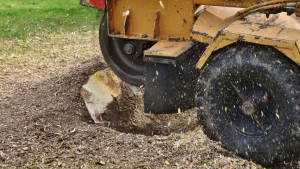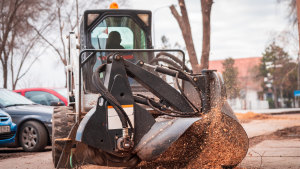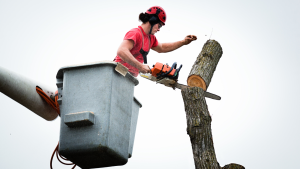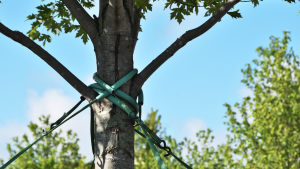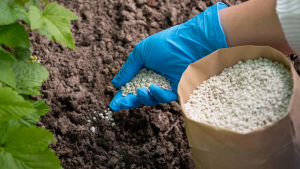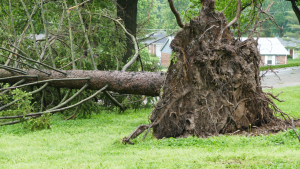Discover the benefits of mulching trees and how to apply them
The citizens of Illinois are doing everything they can to conserve water due to the hot temperatures and lack of rain. Although they might not need daily care, routine maintenance is crucial to maintaining the health, attractiveness, and safety of the trees on your property, particularly during dry spells.
So how can you maintain your trees’ health and irrigation system while still saving water?
Using mulch is one of the finest ways to preserve water while promoting the health of your mature trees and saplings. Mulching is simple, and this protective ground covering not only conserves water but also helps to improve soil and manage weeds. Mulch’s magical power!
You may discover how to mulch trees, how much mulch to use, and which kind is ideal for your needs by following the steps listed below.
5 Ways That Proper Mulching Benefits Trees
Let’s start by taking a look at the big picture and the individual advantages mulch offers your trees. Understanding how mulch functions can you in concentrating your efforts and maximizing the advantages.
1) Maintain soil moisture
By adding mulch around your trees, you can prevent evaporation and save the soil’s valuable moisture for the roots of the trees. This is particularly crucial if you’re watching how much water you use during a drought.
Mulch also inhibits the growth of weeds and grasses, preventing the tree roots from having to compete for water with invasive species. The mulch will then help to stop water loss due to runoff and erosion once it starts to rain.
2) Mild soil temperatures
With the right quantity of mulch, you may also control variations in soil temperature. Mulches keep the ground from being exposed to the light and heat during hot weather, keeping the soil cool. This prevents the top soil around the tree roots from drying up and hardening.
Mulches assist the soil in retaining heat during cold weather, lowering the risk of frost damage or root injury.
3) Enhance soil health
Organic mulch gives the soil structure, nutrients, and aeration as it breaks down. The following section goes into further detail on organic versus inorganic materials.
4) Provide Security
When mulch is applied correctly, it also shields the roots, aids in keeping the trunk dry, and lessens the likelihood of lawnmowers and foot traffic compacting the soil.
5) Ensure weed and
As was already noted, mulching prevents weed and grass development. As grasses and weeds proliferate around a tree’s base, these unwanted plants deprive the tree of nutrients as well as moisture from the soil.
How to Mulch Trees Properly:
Organic vs. Inorganic
There are typically two alternatives when deciding which sort of mulch is ideal for your landscape: organic and inorganic. Both kinds have certain advantages and drawbacks of their own.
Organic Mulch
Organic mulch is the way to go if you don’t mind a little bit more routine maintenance and want to improve the health of your topsoil.
Several varieties of organic mulch are:
- Wood chips
- Straw
- Pine needles
- Shredded hardwood or softwood
- Bark
- Leaves
As we previously indicated, when organic mulches decompose, they enhance soil fertility and improve soil structure. But, organic mulch may need a little more maintenance and reapplication because they do deteriorate with time.
Inorganic Mulch
Inorganic mulch can be the best choice for you if you’d like a more attractive and low-maintenance option.
A few examples of inorganic mulch are:
- Stones or pebbles
- Gravel
- Tarp
- Rubber
While inorganic mulches don’t have the same soil-enriching advantages, they do offer more durable weed control that needs less maintenance.
Inorganic mulches may also be more adaptable in terms of appearance. When it comes to mulch, river rocks or other multicolored stones make lovely additions to your garden.
Mulch to the drip line
Knowing the size of the area you are covering and how near to the trunk you may get is crucial when applying mulch. Mulch should start at the “root flare” and be maintained away from the trunk. At the base of the tree, this is where the roots erupt out above earth.
When the tree grows, the mulch area’s perimeter ought to expand. The “drip line,” or canopy of the tree, should ideally be reached by the mulch.
Do not overmulch.
Overmulching is the most typical mulching error. It is not advised to pile mulch over the root flare and up the trunk. Also, if the soil is poorly drained, the mulch should only be two to four inches deep.
In order to guarantee that the root system receives enough oxygen and water, finer or thick mulch, such as pebbles, should normally only be spread one to two inches deep.
Joliet Tree Service‘s arborists are available to assist you.
You are now aware of all the advantages of mulching for the health of your trees and water conservation. The right procedure, materials, and frequency have also been discussed. It’s time to mulch those trees well right now.
A licensed arborist can assist you if you have a tree that has already had excessive mulching or if you have concerns about the general health of your freshly planted or older trees. To book an arborist inspection if your trees are displaying symptoms of distress, call us at (815) 476-3395 or send us an email.

